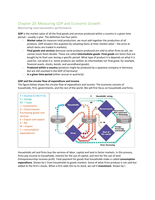Chapter 20: Measuring GDP and Economic Growth
Monitoring macroeconomic performance
GDP is the market value of all the final goods and services produced within a country in a given time
period – usually a year. The definition has four parts:
- Market value (to measure total production, we must add together the production of all
products. GDP answers this question by valuating items at their market value – the price at
which items are traded in markets)
- Final goods and services (because some products produced are sold to other firms to sell, we
cannot count them double. These are called intermediate goods. Final goods are items that are
bought by its final user during a specific period. What type of product it is depends on what it is
used for, not what it is. Some products are neither an intermediate nor final good, for example,
financial assets, stocks, bonds, and secondhand goods).
- Produced within a country (products might be produced by a Japanese company in Germany.
But are still counted in the GDP of Germany)
- In a given time period (either annual or quarterly)
GDP and the circular flow of expenditure and income
The figure below shows the circular flow of expenditure and income. The economy consists of
households, firm, governments, and the rest of the world. We will first focus on households and firms.
Y = Income (C+NT/T+S)
S = savings
NT = Taxes
I = Investments
G = Governments
Purchasing goods and
services
X = Export (net export
X – M)
M = Import
C = consumption
expenditures
Households sell and firms buy the services of labor, capital and land in factor markets. In this process,
firms pay income to households, interest for the use of capital, and rent for the use of land.
Entrepreneurship receives profit. Total payment for goods that households make is called consumption
expenditure. Shown by C from households to goods markets. Some of what firms produce is not sold but
added to the firm’s stocks. When a firm adds this to its stock, we call it investment. Shown by I.
,Governments and rest of the world
Governments buy goods and services from firms which is called government expenditures shown by G.
These are paid for by taxes from households, who on their turn receive unemployment benefits and
subsidies from the government. These are not part of expenditures nor income.
Export and import from and to the rest of the world consists of all goods and services bought and sold
abroad. Net exports can be calculated through X – M.
GDP equals expenditure equals income
GDP can be calculated in two ways: by the total expenditure on goods and services (expenditure
approach), or by the total income earned by producing goods and services (income approach). Total
expenditure – aggregate expenditure – is the sum of the red flows in the figure on page 1. Aggregate
income is shown blue. Thus, Y = C + I + G + X – M. The statements go as follows:
‘’GDP equals aggregate expenditure and equals aggregate income’’
The gross in GDP refers to the fact that depreciation of capital is not included
in the calculation. Depreciation is the decrease in value of a firm’s capital,
and the total amount of purchases of new capital and replacing depreciated
capital is called investment. The amount by which the value of the firm’s
capital increases is called net investment. Thus, net investment = gross
investment – depreciation.
Total expenditure on final goods and services: C + I + G + X – M
Measuring UK GDP
Because aggregate output equals aggregate expenditure and aggregate
income, two ways of measuring GDP are available:
- Expenditure approach (same as counting up the red flow)
- Income approach (sum of all incomes paid by firms to households for the services they hire –
wages for labor, interest for capital, rent for land and profit for entrepreneurship. The incomes
are grouped in three components:
1. Compensation of employees (total payments by firms for labor services. This item includes
gross wages and benefits such as pension contributions, and is shown by the blue flow W).
2. Gross operating surplus (the total profit made by companies and the surpluses generated by
publicly owned enterprises (also dividends from firms to households), shown by P).
3. Mixed income (a combination of rental income and income from self-employment. Rental
income is the payment for the use of land and other rented inputs. Imputed rent is an
estimate of rent homeowners are willing to pay for the houses they own. Shown by M).
The sum of these factors is called gross domestic income at factor cost. When we sum all the
expenditures on final goods and services, we arrive at domestic product at market prices.
The gap between expenditure and income approach is called the statistical discrepancy and is calculated
as the GDP expenditure total minus the GDP income total, naturally.
Nominal and real GDP 1
The know the amount of the gap destined from expenditure- or income approach, we need to
distinguish real GDP and nominal GDP. Real GDP is the value of final goods and services produced in a
given year when valued at the prices of a reference based year. By comparing the value of production in
1Nominal GDP = value of goods and services produced during a given year valued at current prices, Real GDP = value of final goods and services
produced in a given year when valued at constant prices (prices in base year; t-n)
,the two years at the same prices, we can see change in
production. Nominal GDP is the value of final goods and
services produced in a given year when valued at the
prices of that year. Economic tacticians use real GDP.
How real GDP is calculated can be seen in the picture on
the next page.
The picture shows the quantities produced and the prices
of the goods in 2009. In the 2008 part, we calculate the
nominal GDP. In the first 2009 part, we calculate nominal
GDP which is 370,000. In the last part, we calculate the
real GDP in 2009.
We calculate economic growth as:
- The percentage change of real GDP, thus
- An increase in the standard of living (real GDP per person)
- The percentage change potential GDP (all factors of production are fully employed).
The business cycle (conjunctuur)
- Periodic, irregular up-and-down movements of growth.
- Real GDP fluctuates around potential GDP.
The use and limitations of real GDP
We use estimates of real GDP for two main purposes:
To compare the standard of living over time: to compare this, we take the GDP per person in a country.
By using real GDP, we remove any influence that rising prices and a rising cost of living might have had
on our comparison. We are interested in long term trend, which is a handy way of comparing real GDP
per person over time. To do this, we use: Old GDP per person / New GDP per person. The graph below
shows this relationship as well as the growth of potential GDP per person (value of production when all
the economy’s labor, capital, and entrepreneurship are fully employed. A cost of a slowdown of the GDP
can be measures using the lucas wedge, which is the euro value of the accumulated gap between what
real GDP per person would have been if the growth rate
before the slowdown had persisted. A visualization is
seen on the bottom of this page.
The business cycle is an irregular up-and-down
movement of total production and other measures of
economic activity. These are either recessions (a period
of economic contraction – 2 consecutive quarters of
negative economic growth.), or expansions (a period in
which GDP increases). These phases have, on their term,
turning points. These can be either:
- Troughs (temporary low point);
- Peaks (high point).
To compare the standard of living across countries: Two
problems arise in using real GDP to compare living
standards across countries. First, the real GDP of one
country must be converted into the same currency units
, of the other country. Second, the goods and services in both countries must be valued at the same price.
To get a fair view of this, we must value the goods and services at the PPP (or purchasing power parity).
Limitations of real GDP
Real GDP measures the value of goods and services that are bought in markets. Some of the factors that
influence the standards of living, but which are not part of GDP are:
- Household production (washing a car, changing lightbulbs etc. Are all contributing to the
standard of living, but are not part of GDP)
- Underground economic activity (fraudulent selling of goods, hence avoiding tax payments is not
registered and thus not part of GDP)
- Leisure time (leisure time is a good for the standard of living, but not added to GDP)
- Environmental quality
Notes:
Aggregate supply (or total output) is the total supply of goods and services produced within an economy
at a given overall price level in a given time period. It is always upward sloping.






